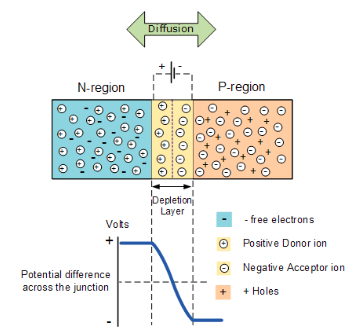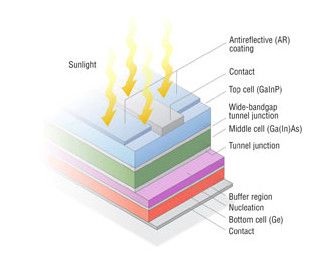Solar panel efficiency is improving constantly, and innovations in solar cell construction, materials, and design are at the forefront of these improvements. Multi-junction solar cells are an exciting technology that may provide increased efficiencies in the solar panels of the future.
What are multi-junction solar cells?
Multi-junction solar cells are capable of absorbing different wavelengths of incoming sunlight by using different layers, making them more efficient at converting sunlight into electricity than single-junction cells. While they have the potential to be many times more efficient than traditional solar cells, high production costs and continuing research and development means that multi-junction cells are not currently commercially available or feasible.
Multi-junction solar cells are a type of tandem solar cell, meaning they are made of stacked materials that are optimized to absorb different frequencies of sunlight.
Multi-junction solar cell basics: how do multi-junction solar cells work?
Solar cells are made of a semiconductor material, typically silicon in crystalline solar cells. Traditionally, a solar cell has two layers: an n-type with a high concentration of electrons, and a p-type with a relatively low concentration of electrons. When sunlight hits the n-type layer, electrons flow from that section to the second and create an electrical current that can be captured and used for power. This type of solar cell is known as a single-junction solar cell, as it has one single boundary/junction between the n-type and p-type layers, known as a p-n junction. These p-n junctions are where electrical currents flow in solar cells.

A multi-junction solar cell is a tandem solar cell with more than one p-n junction. In practice, this means that there are multiple layers of different semiconductor materials, each of which produces electric currents in response to different wavelengths of light. This means that, theoretically, multi-junction solar cells are capable of converting more sunlight that hits them to electricity when compared to single-junction cells.
Just like normal silicon solar cells, multi-junction solar cells produce electricity through the photovoltaic effect. The photovoltaic effect is a complicated chemical and mechanical process, but can be summarized in three main steps:
- Light is absorbed by solar cells and electrons in the semiconducting material are knocked loose
- Loose electrons flow through the p-n junction between semiconductor layers, creating an electrical current
- The current is captured and transferred to wires
Single-junction solar cells have one p-n junction to direct the flow of electricity created when sunlight hits a semiconducting material. In a multi-junction solar cell, there are multiple p-n junctions that can induce a flow of electricity.
Multi-junction solar cell structure
Multi-junction solar cells are not made using silicon as a semiconductor. Instead, materials like gallium indium phosphide (GaInP), indium gallium arsenide (InGaAs), and germanium (Ge) are used to create separate layers of semiconductors that all respond to different wavelengths of incoming sunlight.

Comparing multi-junction and single-junction solar cells
How do multi-junction cells and single-junction cells compare? We’ll take a look at three main factors: efficiency, materials, and pricing.
Efficiency
A solar cell’s efficiency is a measure of what percentage of incoming light that hits the cell can be converted to electricity. In terms of theoretical efficiency, multi-junction solar cells have the potential to significantly outperform traditional single-junction solar cells. According to the Department of Energy, multi-junction solar cells with three junctions have theoretical efficiencies over 45 percent, while single-junction cells top out at about 33.5 percent. Adding more junctions (potentially up to 5 or 6 junctions) could boost efficiency over 70 percent. For reference, the most efficient solar panels available today have efficiencies around 22 percent.
Materials
Single-junction solar cells are typically made using silicon as a semiconductor, while multi-junction solar cells commonly use three separate semiconductors: gallium indium phosphide (GaInP), indium gallium arsenide (InGaAs), and germanium (Ge).
Pricing
There aren’t commercially-available multi-junction solar cells yet, which means that pricing is mostly speculation. One thing is for sure: multi-junction solar cell production is a more complicated and difficult process using more expensive materials, so they’ll likely cost more than single-junction cells when they hit the mass market. The cost of solar panels has steadily fallen over the past several years, however, and as manufacturing processes are perfected, the cost of solar panels made from tandem solar cells will likely follow the same pattern over time.
Can you install solar panels with multi-junction cells?
Multi-junction solar cells are an exciting and promising technology that may help increase the efficiency of solar panels. For now, they are still being tested and researched, and therefore are not available to purchase for solar panel installation.
If you’re interested in solar energy for your property, many top solar panel manufacturers offer high-efficiency products that effectively convert sunlight to electricity so you can benefit from clean and free solar power. Check out your options for a solar installation today by visiting the EnergySage Solar Marketplace, where you can compare qualified, local installers side by side and determine the best solar option for you.






